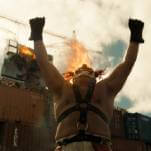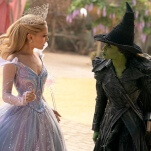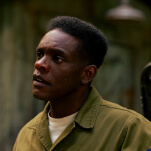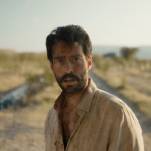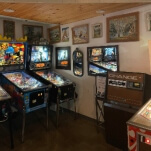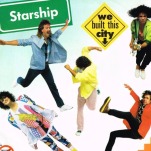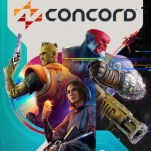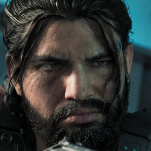It’s fun to see all the obvious references, like Max replenishing his health by eating Dinki-Di dogfood, a nod to Road Warrior’s food of choice. But there are more subtle examples, as well. A notable landmark is a giant statue wearing the same robes and holding the same stance as the briefly seen Dr. Dealgood from Beyond Thunderdome. One warlord dwells in a canopied structure inside her fortress modelled after the one belonging to Tina Turner’s Aunty Entity. The characters speak in the same hybrid patois from the movies that introduced such terms as “Aqua-Cola” and “Guzzleine.” One thing is for certain: Mad Max is no cash-in. If anything, Avalanche Studios’ creation may be too reverent.
In an effort to secure a sufficiently sweet ride, Max turns to a number of besieged communities for aid and odd jobs. In the movies, he would inevitably fall into the orbit of some group of isolated survivors and reluctantly provide them aid. The massive scale of the game’s desert wasteland provides numerous such locales that its Max pursues at leisure. Like the movies, he approaches his dealings with each group’s leaders curtly, kicking off partnerships with a perfunctory, “Let’s do business and be done with each other.” He continues this brusque facade even after becoming a veritable regular within each community. It’s difficult to feel Max’s urgency to flee and leave humanity behind when he functions as the central cog bringing together all the disparate people of the wasteland like a desert messiah.
His monastic negation of self is thwarted at every step by a near-identical series of missions all dutifully performed for the promise of new and better gear. Because man, that upgraded bumper sure does look sweet and might be just the thing you need to finally reach The Plains Of Silence and leave the ghosts of your loved ones behind. Wisely, the game’s Max is not modeled after Tom Hardy’s or Mel Gibson’s visage. If Avalanche had imbued Max with a distinct personality as well, a Max who is a little hungrier for companionship or a little less desperate for escape, the game world would make much more sense.
Avalanche’s reverence for Max is best personified in the first person he encounters, an old hunchbacked sea dog in mechanic’s clothing named Chumbucket. He becomes a constant companion and, due to Max’s silent nature, handles the majority of the dialogue. The game is not necessarily better for it. Chumbucket has created a religion that revolves around Max, “The Saint Of The Wasteland” who The Angel Of Combustion has foretold will drive Chumbucket’s sanctified vehicle, the Magnum Opus. It’s a great concept, but Chumbucket’s constant, repeated proselytizing wears thin over the game’s considerable length.
Max also encounters a mysterious wanderer who attempts to heal the black rift in his soul. This acts as a narrative device draped over the game’s leveling-up system, where a spiritual journey of self-awareness allows you to hit dudes harder with a makeshift club. Like Chumbucket’s mythology, it demonstrates the game’s near-religious reverence for a character that repels such things. It tries to graft the role-playing game conventions of leveling up and statistical progression onto a character that has proven through four movies to be essentially unchanging.
Among the rest of the supporting cast, Mad Max makes some effort to present a diversity of female characters. While the gas-huffing pit-fighter Tenderloin is a delight, the game’s female lead, Glory, isn’t as compelling. A former concubine trying to find a safe haven for herself and her daughter, she is modeled after the escaped wives from Fury Road. But that film’s subtler questions about servitude, identity, and independence aren’t present here. She’s a stock character who only exists to compel Max into action. And her daughter falls into the same oversimplified role all children must perform in games with prickly protagonists: She’s shorthand for the hero’s humanity.
Impeding Max’s quests are three distinct wasteland clans all populated by the same enemy templates. Wherever you are and whomever you’re fighting, strategy remains identical. Fisticuffs have a satisfying crunch but are rarely challenging. Most enemies generously telegraph their maneuvers along with the appropriate button press needed to parry or dodge their strikes. The only time you’re in danger of being beaten down is when you’re vastly outnumbered and surrounded, but since most scuffles have three or four opponents waiting patiently as you repeatedly pound their companion’s head to mush against a pile of gas cans, you can easily emerge victorious from most encounters. One exception is when you initiate an attack one of Scrotus’ many outposts or oil reserves. Suspended above the central arena inside these strongholds will be a War Crier. Roughly modelled after Fury Road’s blind guitarist, the Crier bangs on a drum and riles up the War Boys. If he’s allowed to play long enough, he will buff up your opponents and make your fight much more difficult.
When murdering on foot becomes too tiring, Max can just hop behind the wheel of the Magnum Opus, taking down other vehicles with a dirty combination of collisions and makeshift weaponry. The vehicle’s harpoon gun is the most seamless pairing of the movies’ sensibilities with the anarchic joie de vivre Avalanche Studios displays in its signature Just Cause series. The harpoon can rip off tires to disable vehicles, but it’s much more fun to pull doors away, impale the driver, and send him flying while the harpoon retracts. When cars are too heavily armored, you have the “Thunderpoon” at your disposal. Straight out of Fury Road, it’s an explosive-tipped javelin with a name that sounds like a ’70s exploitation movie title. Tossing one into an oncoming car and plowing through the flaming wreckage is endlessly cathartic.
You continually upgrade the Magnum Opus until your once-simple machine becomes a massive jangling kinetic sculpture, tumorous with jutting spikes and welded-on bits of scrap. Drag racing across the endless highways in your scrub-punk parade float and violently spearing War Boys from their rigs with your harpoon is when the game is closest in spirit to the movies it cares deeply about. Spending dozens of hours in a massive desert could easily become painfully dull, but Avalanche put a lot of thought and vision into each of the world’s distinct areas. You begin the game at the edge of a vast ocean floor, dotted with rusted-out tug boats and chalky white coral. Shifting yellow dunes give way to red canyons. Sulphur pits blend into white alkali flats. Later on, you explore a massive airport swallowed by the sand. It’s as if the great dinosaurs of old transportation have died out and cars are the resilient mammals, scurrying among their bones.
More than the carefully constructed language or the fidelity to a story that doesn’t need to be told, Mad Max is at its best when it offers some of that silence its hero swears to seek. It’s when Chumbucket shuts up, when no deals need to be bartered, when you can just drive—just you belching out fire and black smoke across the highways, shiny and chrome.


